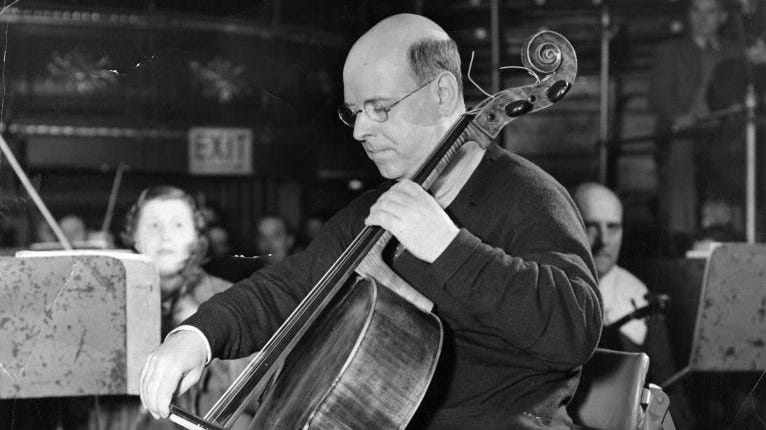
The most recognizable and well known pieces for solo cello, Bach’s six Suites à Violoncello Solo senza Basso, or Suites for Solo Cello without Bass are, like his Goldberg Variations for piano and his Sonatas and Partitas for solo violin, incredibly important and profound works, not only for the cello but for all of music.
We’re not sure of the exact dates when Bach composed them, but the manuscript paper suggests that they were written while he was the Kapellmeister in Köthen, during the period 1717–1723. However, they were not widely known until the early 1900’s, when the great Catalan cellist, Pablo Casals, brought them to the public’s attention. Casals had purchased them in a gift shop in Barcelona in 1889 when he was 13 and they became his daily bread, practicing them every day of his very long life. It was not until 1936, when Casals was 60 years old, that he agreed to record them, thus becoming the first cellist ever to record all six suites. This famous recording has never left the catalog.
In yesterday’s blog post, I shared with you the evolution of musical instruments, and this evolution is very much part of the cello suites’ story. Every cellist has learned these masterpieces, yet we aren’t quite sure if they were even written for the instrument that we now know as the cello! In Bach’s day there were two instruments that were, for the most part, interchangeable: the violoncello da gamba (between the legs), which is the instrument we know; and the violoncello da spalla (on the shoulder), which is an instrument we do not know and has fallen into obscurity. Here is a little description of this fascinating instrument by one of the great early music leaders, Sigiswald Kuijken.
Here is Kuijken’s beautiful recording of all six suites on the Violoncello da Spalla.
So you can see it in action, here is an incredible video performance of the sixth suite on a da spalla cello by Sergey Malov.
The cello (and bow) during Bach’s day was quite different from today, and the way one would’ve approached these pieces with these instruments would’ve been different than with a modern cello. Here is a beautiful video by my friend, Marianne Dumas, of the first suite.
In fact, Marianne has compiled ALL of the recordings available of Bach’s Cello Suites on one wonderful website.
One of my favorite cellists, Anner Bylsma, recorded the suites on a couple of occasions, also with Baroque practice in mind. This is a great video showing his deep musicality.
Another Dutch cellist who I’ve always enjoyed listening to perform the suites with a baroque instrument is Pieter Wispelwey.
Here’s a fascinating documentary on the suites that centers around Wispelwey’s third complete recording.
There are also great artists on the modern cello who have made celebrated recordings and given fantastic performances. One of the most recent is Yo-Yo Ma’s of all six suites at the 2015 BBC Proms.
And I find his latest recording from 2018 to be incredibly insightful.
Pierre Fournier’s celebrated 1960 recording is a classic!
Lynn Harrell, who sadly passed away yesterday, has a splendid recording that is loved by many.
And we can never forget the great Janos Starker.
